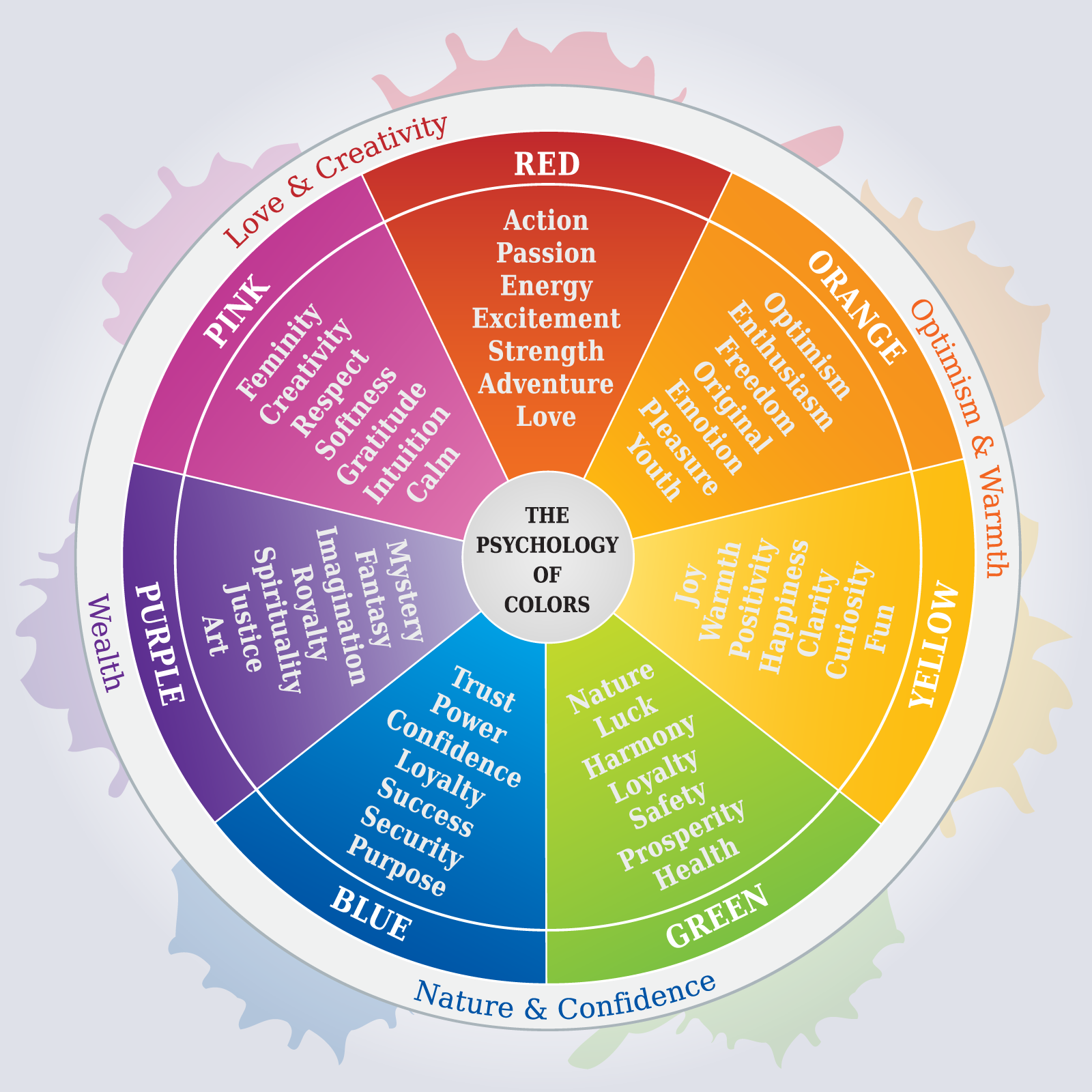Colors are more than mere visual experiences they are powerful communicators that influence emotions, drive decisions, and shape our perception of the world. Whether in nature, branding, fashion, art, or interior design, colors play a vital role in how we feel, behave, and connect with our environment.
In this comprehensive guide, we explore the psychology of colors, the symbolism behind different hues, and their application in marketing, design, and everyday life. Understanding colors allows us to make informed and impactful choices, enhancing both visual appeal and emotional resonance.
The Psychology of Color: How Colors Influence Human Behavior
Color psychology is the study of how hues affect human mood, perception, and behavior. Scientific studies and marketing data consistently show that colors can evoke emotions, influence purchasing decisions, and alter how we interpret information.
Key Psychological Effects of Colors:
Red: Excitement, urgency, passion, power
Blue: Trust, calmness, intelligence, serenity
Yellow: Optimism, warmth, clarity, attention-grabbing
Green: Growth, nature, health, stability
Orange: Creativity, enthusiasm, energy, friendliness
Purple: Luxury, spirituality, sophistication, wisdom
Black: Elegance, authority, mystery, formality
White: Purity, simplicity, cleanliness, innocence
Pink: Romance, compassion, femininity, sensitivity
Brown: Earthiness, reliability, comfort, ruggedness
Each color can trigger subconscious responses, making them essential tools in branding, advertising, and emotional storytelling.
Color Symbolism Across Cultures
Colors hold different meanings around the world. Cultural context plays a critical role in how a color is perceived.
Examples of Color Symbolism:
Red:
Western cultures: Love, passion, danger
China: Good luck, happiness, celebration
White:
Western cultures: Purity, weddings, peace
Eastern cultures: Mourning, death, spirituality
Black:
Western cultures: Sophistication, mourning
Africa: Age, maturity, masculinity (in some regions)
Green:
Islamic cultures: Sacred, associated with paradise
Western cultures: Environmentalism, money, renewal
Purple:
Western cultures: Royalty, luxury
Thailand: Mourning (for widows)
Understanding these cultural interpretations is essential for global brands and designers working across different regions.
Primary, Secondary, and Tertiary Colors
Color theory categorizes hues into primary, secondary, and tertiary colors to help understand how colors mix and interact.
Primary Colors
Red, Blue, Yellow
These cannot be created by mixing other colors.
Secondary Colors
Green, Orange, Purple
Formed by mixing two primary colors.
Tertiary Colors
Created by combining a primary color with a secondary color:
Red-orange, Yellow-green, Blue-violet, etc.
This system forms the color wheel, a foundational tool in design, allowing professionals to create balanced and harmonious palettes.
Warm vs. Cool Colors and Their Emotional Impact
Colors are often grouped as warm or cool based on the feelings they evoke.
Warm Colors (Red, Orange, Yellow)
Associated with heat, energy, passion, enthusiasm
Stimulate the senses and are ideal for calls to action in advertising
Cool Colors (Blue, Green, Purple)
Evoke feelings of calm, tranquility, trust, and professionalism
Commonly used in healthcare, finance, and tech industries for their reassuring effect
Using a balance between warm and cool tones creates visual interest and emotional depth in design.
Colors in Branding and Marketing
Colors are strategic tools in brand identity and consumer psychology. Successful companies leverage color to establish recognition and influence buyer behavior.
Examples of Brands and Their Color Strategy:
Red: Coca-Cola, YouTube – stimulates excitement and urgency
Blue: Facebook, IBM, Intel – conveys trust and reliability
Yellow: McDonald’s, Snapchat – projects happiness and optimism
Green: Starbucks, Whole Foods – suggests health and sustainability
Purple: Hallmark, Cadbury – emphasizes luxury and creativity
Black/White: Nike, Apple – minimalism, power, and modernity
Color contributes to brand recall, with studies showing that up to 80% of consumers recognize brands based on color alone.
Color in Web and Graphic Design
In digital design, colors are essential for enhancing usability, accessibility, and emotional response.
Key Principles in Color Design:
Contrast: Ensures readability and visual hierarchy
Complementary Colors: Located opposite on the color wheel; used for bold, dynamic contrasts
Analogous Colors: Adjacent on the color wheel; provide harmonious, cohesive palettes
Monochromatic Schemes: Variations of a single hue for a minimalist and professional look
Designers must also consider color blindness and accessibility standards, ensuring that content is inclusive and legible for all users.
Colors in Interior and Fashion Design
Interior Design:
Colors shape the mood and function of a space.
Cool tones make rooms feel larger and more serene.
Warm tones create coziness and intimacy.
Neutral palettes (grays, beiges) provide flexibility and timeless appeal.
Fashion:
Color influences perceptions of personality, mood, and formality.
Black is slimming and sophisticated.
White suggests elegance and simplicity.
Bright colors can highlight or distract depending on usage.
Color trends in fashion and interiors shift with seasons, psychology, and cultural influences.
Colors in Nature and Symbolic Meaning
Nature is a profound inspiration for color symbolism:
Green represents life, growth, fertility
Blue skies and oceans symbolize peace and depth
Sunset hues evoke emotion and reflection
Floral colors often carry symbolic meanings:
Red roses = love
White lilies = purity
Purple orchids = admiration
Nature’s use of color also serves biological functions—camouflage, warning, attraction—which humans have mimicked in design and technology.
Digital Color Systems: RGB and CMYK
Color representation varies depending on the medium:
RGB (Red, Green, Blue):
Used for digital screens. Colors are additive—combined light creates color.
CMYK (Cyan, Magenta, Yellow, Black):
Used in print media. Colors are subtractive—inks absorb light to produce color.
Designers must adjust color modes accordingly to maintain color consistency across digital and print platforms.
Emerging Trends in Color Usage
As technology and culture evolve, so does the language of color. Recent trends include:
Neo-mint and digital lavender: Popular in tech and fashion
Sustainable green tones: Reflecting eco-conscious values
Bold neons and pastels: Used in Gen Z-focused design
Muted earth tones: Symbolizing grounding and minimalism
Global events, social movements, and technological innovations often influence the palette preferences of each generation.
Conclusion
Colors are a universal language, deeply rooted in psychology, culture, and experience. From the digital realm to physical spaces, color decisions carry weight and meaning. A strategic use of color enhances emotional engagement, visual storytelling, and brand identity, making it an indispensable element of successful design and communication.
Understanding color theory and symbolism empowers us to craft impactful visual experiences that resonate across cultures, platforms, and industries.



















